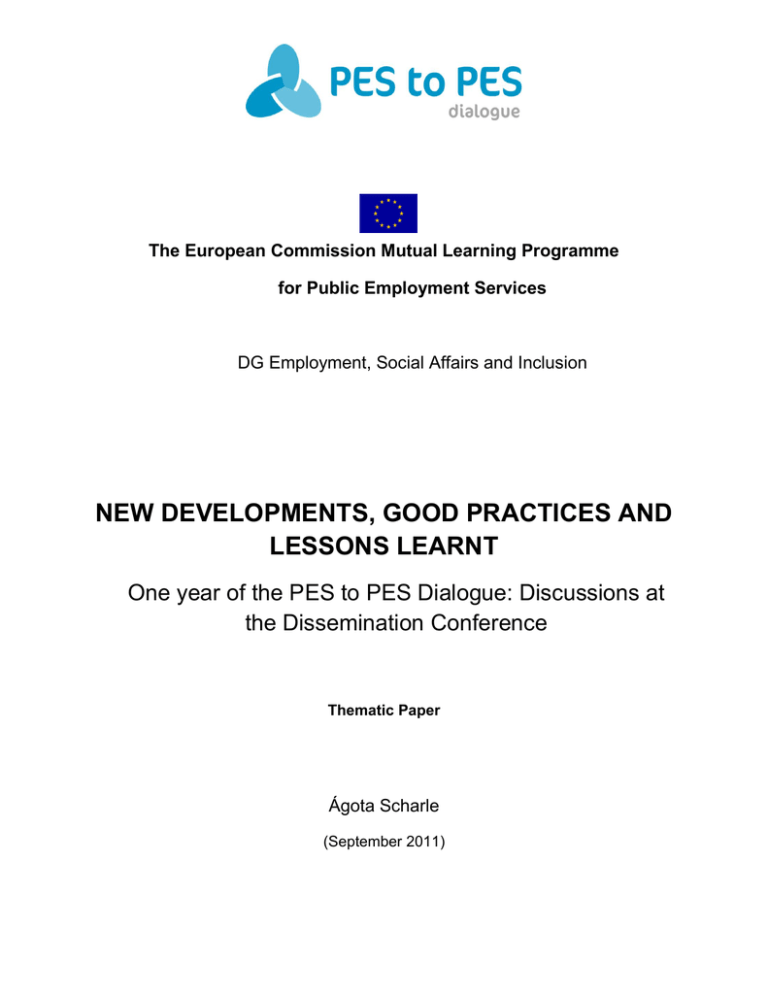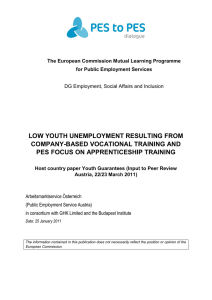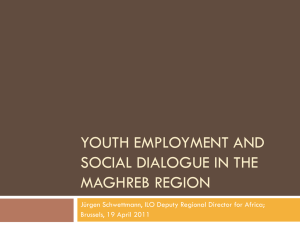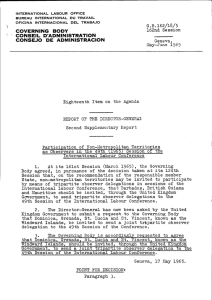One year of the PES to PES Dialogue
Anuncio

The European Commission Mutual Learning Programme for Public Employment Services DG Employment, Social Affairs and Inclusion NEW DEVELOPMENTS, GOOD PRACTICES AND LESSONS LEARNT One year of the PES to PES Dialogue: Discussions at the Dissemination Conference Thematic Paper Ágota Scharle (September 2011) 1. INTRODUCTION: ONE YEAR OF THE PES TO PES DIALOGUE PROGRAMME This report summarises the main reflections from a conference which was dedicated to the discussion and dissemination of results from the first year of activities of the “PES to PES Dialogue” programme to both PES representatives and a wider policy audience. The Commission launched this specific mutual learning programme for public employment services (PES) in September 2010 to improve the efficiency of labour market interventions by increasing PES capacities for service delivery. The PES have played an important role in the achievement of the European Employment Strategy targets by turning employment policy orientations into concrete actions. This role is set to continue – if not strengthen – in taking forward the priorities of the Europe 2020 Strategy and the corresponding employment guidelines. Important references to PES functions in the Europe 2020 Employment Guidelines Guideline 7: Increasing labour market participation of men and women, reducing structural unemployment and promoting job quality “Employment services play an important role in activation and matching and they should therefore be strengthened with personalized services and active and preventive labour market measures at an early stage. Such services and measures should be open to all, including young people, those threatened by unemployment, and those furthest away from the labour market”. Guideline 8: Developing a skilled workforce responding to labour market needs and promoting lifelong learning “Member States should promote productivity and employability through an adequate supply of knowledge and skills to match current and future demand in the labour market. This includes effective incentives for lifelong learning of those within and outside employment (including opportunities for second-chance learning) with efforts focusing on supporting those with low and obsolete skills, increasing the employability of older workers. Other points of relevance for PES work are the improvement of access to training, strengthening education and career guidance combined with systematic information on new job openings and opportunities, promotion of entrepreneurship and enhanced anticipation of skill needs as well as to remove barriers to occupational and geographical mobility of workers encompassing the recognition of qualifications and competences”. 1 The activities of PES to PES Dialogue are guided by, and contribute towards, the work of the European Network of Heads of Employment Services (HoPES). Each of the topics addressed in this conference are key issues on the agenda of PES, proposed by and agreed with the HoPES network. The first dissemination conference of the PES to PES Dialogue programme covered six key policy areas which had been discussed at peer review conferences or explored by background papers during the first year and which take into account the different business models of PES in Europe. The policy areas covered were: Strengthening employment service delivery systems How PES can further enhance service delivery within the context of decentralisation. PES and personalised services How PES can use innovative profiling tools to best identify and serve groups at risk of long-term unemployment. How PES can contribute to the provision of lifelong guidance (LLG) and encouraging lifelong learning (LLL) in order to contribute to a wider employability and skills agenda How PES can use e-services and multi-channelling to maximise the efficiency and effectiveness of their service offer. PES approaches for target groups How PES can maximise scarce resources by intensifying support for priority groups such as low-skilled young people and senior people. The rest of this summary presents the most important conclusions and ideas that emerged from the discussions in each of the six areas, while making links to the relevant outputs of the programme (results from Peer Reviews, analytical papers etc). 2 2. DECENTRALISATION: FINDING THE RIGHT BALANCE BETWEEN FLEXIBILITY AND ACCOUNTABILITY Decentralisation can take the form of managerial decentralisation, which most often involves the reorganisation of the centrally coordinated PES services along the lines of management by objectives. There is a more recent trend of political decentralisation, which may take the form of devolving some PES functions to regions or municipalities. The analytical paper on decentralisation prepared for the PES to PES Dialogue programme discusses these trends in more detail. The main issue in both cases is to find the right balance between flexibility and accountability, which will depend on the surrounding institutional structures and the underlying political goals. Increased flexibility is a clear advantage of decentralised institutions. Local agents may be better informed of local needs, can innovate and adapt their policy tools as needed and may also be more accountable – at the local level at least. The benefits of increased flexibility, however, can only be reaped if local agents are indeed granted considerable freedom in spending their budget, setting targets, choosing target groups, designing their programmes, and organising service delivery. They also must be well informed, equipped with analytical capacities and be part of a national learning system to share ideas and help prevent mistakes. Some PES functions may best be kept centralised (flexible centralisation). For example, efficient job matching services require a national database in order to support regional mobility and data collection must be standardised in order to ensure high quality and comparable information. The autonomy of decentralised institutions also entails some risks. While local agents may be closer to local needs, their interests may not fully coincide with national policies and their actions may not add up to a coherent employment policy at the national level. Transparency in performance results of regional or local offices and a national performance management and labour market information system may help reduce these risks. Decentralisation may also lead to inequalities in the allocation of resources and service delivery. This can be remedied by the careful design of funding mechanisms, including compensating factors for poorer regions, and by imposing minimum service standards or citizens’ charters that guarantee a uniform range and quality of basic PES services to be accessible throughout the country. 3 Denmark is a good example for reconciling local flexibility with control over national goals. The Danish PES used to work in isolation: it had very little contact with local educational institutions or development agencies and took little notice of the policy goals of these actors. The decentralisation of some PES functions in Denmark was seen as a tool to integrating policies at the local level to achieve employment growth. Though national performance targets are still set by the central government, local PES offices are given considerable autonomy to address these priorities given the local context. European employment policy itself may be considered as an example of political decentralisation whereas common goals are voluntarily developed and spread in combination with common strategies (i.e. European Employment Strategy). The OECD Local Economic Employment Development (LEED) mission is to contribute to the creation of more and better jobs through effective policy implementation, innovative practices, stronger capacities and integrated strategies at the local level. Research by the LEED network has shown that greater local flexibility in delivery mechanisms contributes to producing better labour market outcomes. From the perspective of local labour market and employment policy, there is a need for cooperation among a range of relevant actors providing employment, education, training, local economic development and social services; this requires a degree of local autonomy for PES and other actors. 4 3 PROFILING SYSTEMS FOR TARGETING SERVICES AND SCARCE RESOURCES Various profiling tools have been developed by PES in many countries to better target services and scarce resources. There has increasingly been a move away from profiling tools only focussing on a job seekers‟ “hard” skills, qualifications, work experience and career ambitions, to capturing other factors of increasing relevance to potential employers, including soft skills and attitudes which can influence the likelihood of successful labour market integration. New innovative tools also often rely more on ICT, either as a way to offer self-assessment and action planning tools or to exploit the rich sources of information accumulated by the PES. Further details on these trends are provided in the related synthesis paper and presentations at the Dialogue conference in May 2011. KodiaK – the (soft) skills assessment tool (Germany) KodiaK a recently piloted new tool of the German PES includes five services that assess different areas of competence. (A review of recent holistic approaches is provided in the related discussion paper.) KODIAK is a mixed-media tool, operated by in-house psychologists and assistants in cooperation with employment advisers. It employs a combination of web based self-completion questionnaires and face to face counselling. Initial tests suggests that it is important to involve a multidisciplinary team, including psychologists and to equip placement officers with consulting expertise so that they can confidently discuss the more sensitive issues that the use of KodiaK tends to evoke. While clients perceive the tool as highly professional and efficient, placement officers are not fully convinced of its merits and its cost efficiency also remains to be verified. 5 Profiling is increasingly used to support decisions on resource allocation (see related discussion paper). Statistical profiling tool for risk identification (Finland) Introduced in 2007, this tool utilises the large individual level dataset collected by the line ministry about the unemployed, covering demographic characteristics, disability and employment history. Based on econometric estimations of the effect of each characteristic on labour market outcomes, the tool is able to predict the risk of long term unemployment for each client, using their unique work history and personal profile. Tests have shown that it correctly predicts long-term unemployment in 9 cases out of 10, which means that significant gains in segmenting clients could be secured if counsellors used it on a regular basis. So far however, its impact has been limited, as counsellors have misgivings about the accuracy of its predictions and do not rely on it, nor discuss the results with the clients. So, the challenge is not in further refining the tool but in getting counsellors to start using it. Private sector providers often use profiling in innovative ways. Holistic and dynamic profiling (private provider Ingeus) Profiling (assessment) is perceived as an ongoing diagnostic process, where the objective is to achieve sustainable employment. To measure the progress in cases of complex integration processes with a longer duration, profiling is used at several stages of the process (dynamic profiling). It .does not only focus on short-term barriers to labour market re-entry, but comprises a longer-term view. As private providers often specialise on hard to help groups, employment advisors use a holistic and highly personalised approach and usually combine the built-in advice of IT based profiling tools with their own professional judgment. There is considerable potential in the cooperation between private providers and the PES, especially for target groups that require particular attention and a multidisciplinary approach, which private providers are often better equipped to supply. This would require a more efficient use of the information available to the various institutions and new, secure ways of sharing information on clients. As noted in the examples above, recent experience in several countries has shown a certain disillusionment with statistical profiling and self-help tools, partly because the results of some purely self-help tools can lack reliability and partly because of hesitancy among PES staff to take-up even well-functioning tools. An increased understanding is emerging that the introduction of such tools needs to go hand in hand with change management processes involving staff in development and piloting. Communication and training for managerial as well as front-line staff is key to the success of such developments. 6 4 PES AND LIFELONG GUIDANCE: SUPPORTING LABOUR MARKET ADAPTATION Guideline 8 of the EU2020 Employment Strategy highlights the role of the PES in strengthening career guidance and access to training. An increasing number of PES see their role in the future as a „transition broker agency‟ that would support people in making the many transitions during their working lives and employers in matching the rapidly changing job profiles with the competences of the available workforce. While some PES provide guidance services themselves, more work in strategic partnerships with specialised providers to deliver such services. The role which can be played by PES is discussed in detail in an analytical paper. Recent labour market developments require the PES to strengthen their LLG services. However, they are also under pressure to serve more clients and wider target groups in less time and often with fewer staff. The use of profiling and customer segmentation to deliver personalised services and combining face to face with self service channels may help them meet this challenge. Although the PES are well placed to play an important role in implementing LLG strategies and the Employment Committee has clearly indicated their support for the PES in this role, PES experts appear to be divided over the issue of how far PES core services should be stretched. While there is a consensus about quality guidance services for jobseekers and employers, there is large variation across member states in the involvement of the PES in providing specialised career guidance services for young persons or adults. Several member states have invested in expanding the provision of guidance services by the PES or related public institutions, e.g. in Belgium, Hungary, or the UK. Lifelong guidance network, methodology and website (Hungary) In Hungary, under the leadership of the Hungarian PES, a new cross-sectoral lifelong guidance network, methodology and website have been established. The project, funded with support from the European Social Fund, includes mapping the current guidance professionals in all sectors, extending existing training provision for such professionals, establishing a new „sector-blind‟ network of career guidance professionals, and developing a national lifelong guidance portal. The PES also provides the secretariat for the National Lifelong Guidance Council. To better cope with the challenges of an ageing and shrinking labour force resulting from demographic change, a number of PES are developing new strategies for widening their service provision. They offer services not only to the unemployed but also to employers and employees, and also make a special effort to reach vulnerable groups. The ageing of the population will generate more demand for guidance services as employers will increasingly find it difficult to fill vacancies. A point of discussion was that PES can help employers to adapt to this by changing their 7 attitudes and be more flexible in the hiring process: hire from abroad, accept the second best, hire youth and train them, etc. Efficient LLG services are based on evidence. Impact measurement is not only a means to ensuring the efficient use of limited resources but also an opportunity to make the added value of guidance visible. However, currently there is very little information available, particularly on outcomes. Studies are difficult and expensive, partly because most PES do not have the systems needed to collect the data necessary for measuring impact over time. Partnership approaches are widely accepted and are also attractive as many PES are under resource constraints. Strategic and service partnerships with educational institutions are especially important and may yield added value if PES can support these institutions to adjust their guidance services to the needs of the labour market. Liaising with employers and their associations is also gaining importance. Lastly, EU level networks of PES and other institutions involved in LLG play an increasing role as platforms for mutual learning. The European Lifelong Guidance Policy Network (ELGPN) established in 2007 aims to deepen awareness of the four priorities of the 2008 Council Resolution on LLG, which concerned the importance of career management skills, access to LLG, quality assurance and evidence base of guidance services, and coordination and cooperation among the various national, regional and local stakeholders. ELGPN works on both national and EU levels and is involved in producing reference tools for policy and service development as well as collecting and disseminating good practice. Their website and events can be used by PES as an information platform. More formally, cooperation already exists between ELGPN and the European network of Heads of PES (HoPES). National delegations will be set up again shortly allowing national PES to send representatives to the national delegation to the ELGPN. 8 5 E-GOVERNMENT AND MULTI-CHANNELLING MAY INCREASE EFFICIENCY BUT COME AT A COST In line with the Europe 2020 Digital Agenda PESs in Europe increasingly offer online services such as: registration, vacancies advertisement, job search, automatic matching of jobseekers' profiles with jobs or communication via social media. “Integrated Multi-channelling” was the focus of the second Peer Review of PES to PES Dialogue. The analytical paper “Personalised services and e-government” to be published at the PES to PES Dialogue website provides a more detailed account of recent trends in this area. There is wide variation in both the maturity of the various online services and media and in the penetration of such media in PES services across Europe. While PES underline that service improvement is their priority, the growing interest in new media is sometimes motivated by the need to cut costs. However, the experience of several PES suggests that savings may only come in the long run. Costs and sustainability are key issues. Due to the novelty and complexity of these tools, it is essential that investments are carefully prepared. It is important to realise that multi-channelling is as much about change management as about information technology. For example, some PES have started using social media as a channel and abandoned it later, lacking the staff to maintain them. In other cases the new media was left unused as staff were not sufficiently prepared for using it and were convinced of its merits. PES experts shared the view that multi channelling management is not a strategy to reduce costs, at least not in the first place. The primary aim is to free up the advisor‟s time for face to face service and guidance, offer more possibilities to the customers and improve the efficiency of the service. Implementation of a multi-channelling strategy (Austria) Recognising the inefficiency of their early investments in new media, the Austrian PES has taken a very systematic approach to reshaping their system. Two key lessons emerged from their experience. Firstly, the huge potential in learning from the past experience of other PES who had successfully implemented multichanneling systems. Secondly, the importance of involving PES staff right from the beginning. An initial survey of PES staff revealed that only 55% of counsellors were both equipped with the necessary skills and felt ready for the change, while 45% were unprepared in one or the other dimension (or both). In the Austrian case, this was tackled not only by training but by taking an approach based on team work, staff involvement and regular feedback. The key to efficient multi-channelling is to choose the right channel for the right service for the right people. The design of channels must take into account the 9 characteristics not only of the particular service and of the particular channel, but also the broader context of the organisation where the service takes place. The personal characteristics of users must be accounted for both in the design and in the delivery phase. This requires screening readiness to use given channels, and offering training to prepare some groups for the use of some tools. It is important to accept as a starting point that most people prefer a face to face channel and that habits are very difficult to change. Lastly, experts also stressed the importance of integrating databases so that job seekers and advisors share the same information. This helps reduce mistakes, improves time management and may also yield some time savings on data entry. 10 6 PES SERVICES FOR AN AGEING WORKFORCE Given an ageing and shrinking workforce as a result of demographic change the Europe 2020 strategy recognises the need to increase labour force participation particularly amongst women, older workers and the inactive. It is important to consider the wide variation across member states in both the extent of the ageing problem and the institutional and labour market context. For example, employers tend to be more open to new approaches in countries where ageing and the ensuing skills shortages are at a more advanced stage. Similarly, some solutions are easier to implement in some countries, e.g. part time work is more wide spread in higher income member states, or self-employment is easier to promote where administrative burdens are low. The analytical paper provides a more detailed account of these issues. Economic research shows that financial incentives, especially in taxation, rules of early retirement and access to unemployment and disability benefits are crucial for activating senior workers. However, this must be supplemented by further measures to increase labour demand and also to change perceptions about ageing and labour market participation. On the demand side, wage subsidies are widely used by member states, although their efficiency is sometimes questioned on account of substitution or deadweight effects. The promotion of combinations of part time employment with partial retirement or with self-employment is a promising tool, but it must be used with caution so that it does not re-open early retirement routes. Services to employers supporting recruitment and direct campaigns against ageism may also help to convince firms to hire senior workers. On the supply side, training vouchers appear to be an efficient tool proven by research and their use is rapidly spreading (recently introduced in e.g. Bulgaria, Latvia, and Poland). There is convincing evidence that vouchers are most successful when they allow individual choice. For example, a controlled experiment with the Dutch individual learning account showed that results were best for older workers who were allowed to make a decision for themselves on how to use their account. Perceptions and attitudes are crucial on both the demand and supply side. Employers need to be convinced of the value of senior workers and job seekers need to be motivated to change their expectations as well. Recent evidence from member states suggests that negative perceptions of their health and employability, as well as unrealistic wage expectations can be strong barriers that need to be tackled. For example, face-to-face counselling has been found to foster individual responsibility for employability. Clubs and other networking opportunities for senior workers are also used by several member states with considerable success. 11 The PES play an important role in all the above areas. Preventive actions include the provision of support for LLL and gaining new skills, convincing both employees and employers to invest in their skills. It is a challenge however that the results of preventive actions are not so visible, so that some PES may have difficulty to get funding for them. Curative actions focus on getting people back into the labour market. Some PES use measures targeted specifically at older workers, while others do not use cohort targets, but aim to offer highly individualised services. Apart from traditional PES roles, two new areas emerged as especially beneficial. The first one is the promotion of focusing on competence additionally to qualifications and accrediting skills acquired through job experience. For example, in France, Pôle Emploi (PES) staff are equipped to assess the skills of workers, based on which they can issue a formal accreditation of any professional experience gained in the workplace and can also use this information to support employers in the recruitment process. The second novel area is to initiate and facilitate cooperation and consultation with stake-holders at the national and local levels. Cooperation is needed both for changing perceptions about senior workers and for identifying and removing the barriers to active ageing which tend to affect a wide range of policy areas and actors. Strategic partners include for example NGOs and age-pressure groups, medical service providers, temporary work agencies, employers‟ associations and local partnerships. Employment Pacts for Older Workers in the Regions (Germany) Local PES centres play a leading role in Germany within the Federal programme, „Perspektive 50plus Beschäftigungspakte für Ältere in den Regionen‟ (Employment Pacts for Older Workers in the Regions) which seeks to increase the employment chances for those over 50. This programme is intended to find regional and local solutions by addressing and convincing regional or local companies, workers themselves and the public, of the advantages of older workers, and to reduce the barriers for their access to the labour market. Experts stressed the need for the PES to invest in information systems, the knowledge base on senior workers and staff development. For example, training vouchers allowing individual choice require well developed information systems, preferably at the national level, providing information on the quality of training courses. Another important lesson from the previous 50+ programme in the UK was that all advisors need to be aware of the issue of ageing, not just specialised 50+ advisors, as skills deficiencies can be tackled much easier at an earlier age. 12 7 PES NEED MORE TOOLS TO REACH LOW SKILLED YOUNG PEOPLE The new European Commission Initiative “Youth on the Move” emphasises the need for early intervention to prevent the scarring effects of unemployment (Youth Guarantee). The first Peer Review of PES to PES Dialogue focused on “Youth Guarantees: PES approaches and measures for low skilled young people”. Lessons from the conference and from two background papers were summarised in a thematic synthesis paper. The focus on young people is justified by the fact that they are especially vulnerable to cyclical variations in labour demand, and by the long term implication that the initial difficulties of entering the labour market lead to permanent detachment. In response, some member states (with Nordic countries taking the lead) have developed specific measures to ensure early intervention and prevention already in the 1980s. Some of these take the form of so called youth guarantees, which establish the right of young job seekers for activation including training and job opportunities and oblige the PES to offer such services. Beside early intervention it also appears important to use a holistic and integrated approach to tackle all the barriers (ranging from learning difficulties to family problems) to employment, which requires the PES to cooperate with multiple actors. For a more detailed review of good practice in Europe, see the related analytical paper. Motivating young people to use PES services appears to be difficult in most member states, especially in the case of disadvantaged youth who often have less contact with other institutions as well. Outreach activities to make contact with young people (Austria) Experience from Austria suggests that it helps to use various channels, e.g. youth centres, schools, religious organisations, social workers, leaders of ethnic communities, and also multiple media, ranging from face to face counselling to targeted websites and PR videos on YouTube (see host country paper for more detail). Specialised PES offices with specifically trained advisors and multidisciplinary teams have also proved to be effective. While off-site outreach activities are very important, the Austrian PES found it more effective to invite schools to visit PES offices rather than lecturing at pupils in school. Such visits tend to achieve more involvement both from the pupils and their teachers. Apart from outreach activities, effective services include vocational counselling delivered by PES or other actors “trained” or contracted by PES, mentorship programmes, action plans, which help to build a trust relationship between PES staff and young job seekers and services to employers who agree to employ disadvantaged youth. The efficiency of these services can be improved by involving young people in 13 both designing and delivering services, employing multidisciplinary teams (especially psychologists), extending the profiling tool to cover soft skills and family background, and investing in follow up. Timing is also important to prevent de-motivation. In Austria for example, the first in-depth interview (with counselling) must take place within 8 days, and an action plan must be drawn within 3 weeks of first contact. Effective ALPMs combine training with workplace experience and incentives for employers to recruit disadvantaged young people. PES views appear to diverge on the issue of skills development. In some member states (e.g. Denmark and the Netherlands) it is a clear priority that all school leavers must possess basic learning skills before entering the labour market while in others vocational training and immediate employment are accepted as equally positive outcomes (e.g. in Austria). In the former case, the PES would assess competencies, closely cooperate with schools to identify youth lacking basic skills at an early stage and refer them to second chance schools or other training institutions. However, the education sector is not sufficiently developed even in these countries to deal with the complex needs of disadvantaged youth. Though their long term efficiency is widely accepted, the cost of youth-oriented PES services and measures may be prohibitively high. However, total costs can be reduced by careful targeting. Schools have a central role in this as they have the information on which students need particular attention: in Denmark for example, schools collect information on the competencies of their students and share it with the PES. For a more detailed review of the various measures and services provided by member countries see the related comparative paper. 14 8 NEXT STEPS FOR THE PES TO PES DIALOGUE The first year of PES to PES Dialogue has already made it possible to exchange information on a multitude of subjects and has added value for PES organizations who have made use of the opportunity to exchange information and good practices with their counterparts in other Member States. The Dialogue Programme will continue to be driven by the EU2020 agenda and priorities developed within HOPES. Particular emphasis was placed on the emerging enhanced co-operation between policy makers in EMCO and the HOPES network and between the PES to PES Dialogue and EMCO‟s own Mutual Learning Programme. Similarly, links with other networks, such as ELGPN will also be continued and enhanced. In order to enhance this dialogue, it was considered beneficial to develop a common Glossary of Terms to avoid misunderstanding and enrich the clarity of the debate. Many of the key priorities of the PES to PES Dialogue Programme in 2011/2012 have already been set, but will also continue to be shaped by HOPES. 2012 will see: Peer Reviews on the issue of PES and services for employers and PES and older workers and. A Dialogue Conference will elaborate on the use of Individual Action Plans in the activation and integration of job seekers. Analytical papers will focus on services for employers; target setting and controlling in PES; job profiles and training for employment advisors; and PES as learning organisations. Further themes will be defined on an ongoing basis and PES representatives at the conference were invited to put forward their priorities, emphasising the nature of the PES to PES Dialogue as a programme very much for and controlled by PES organisations. 15






